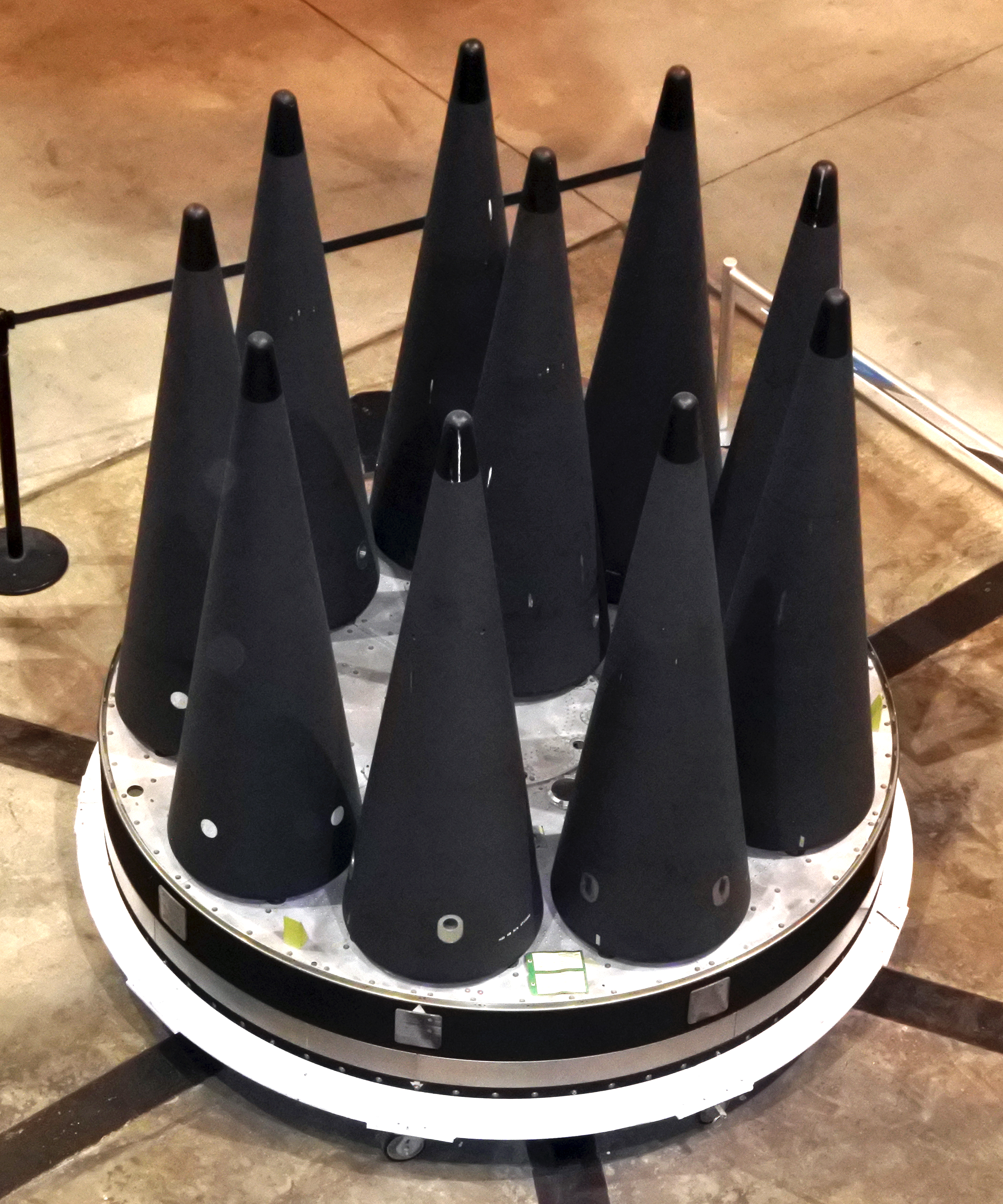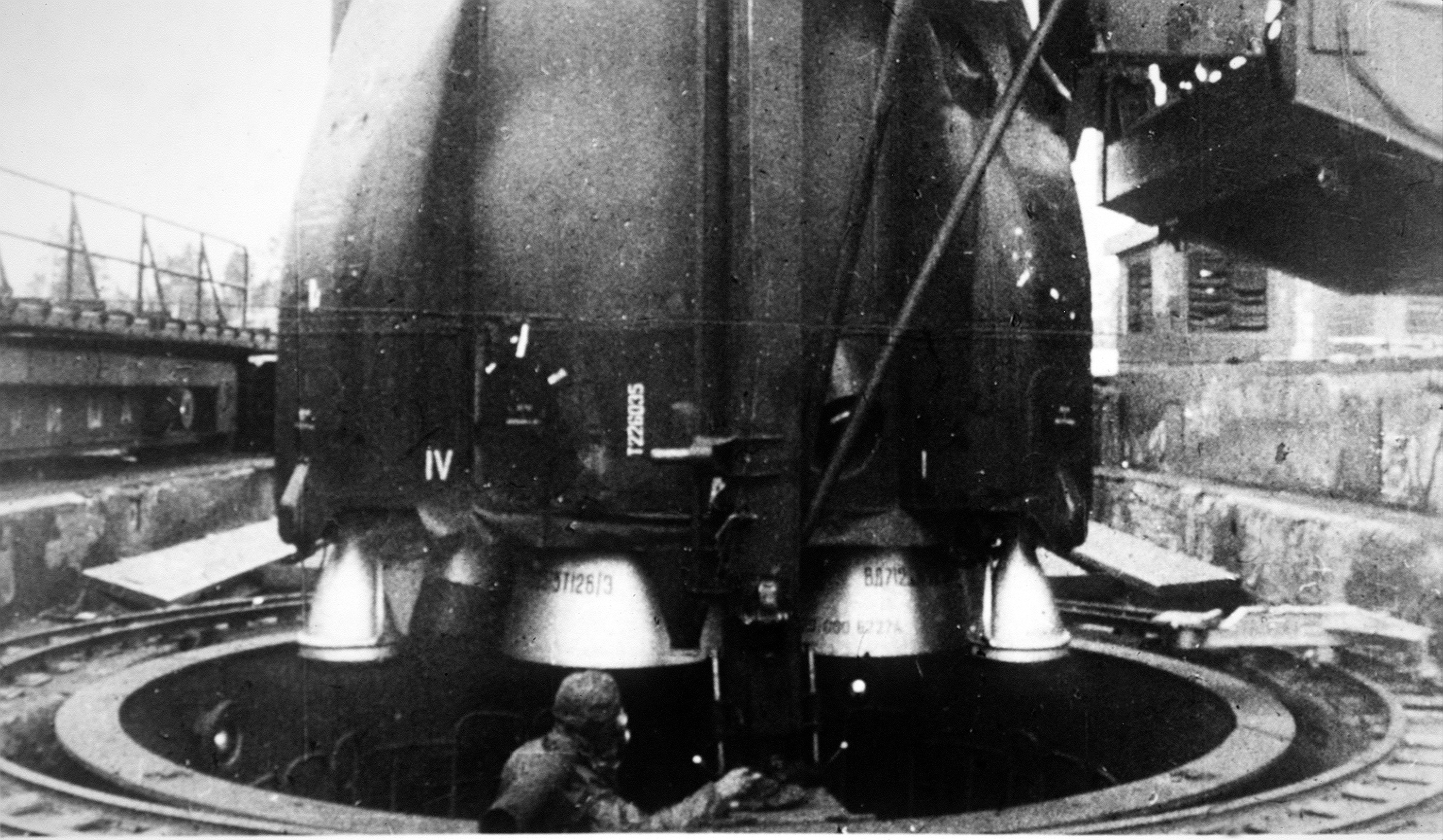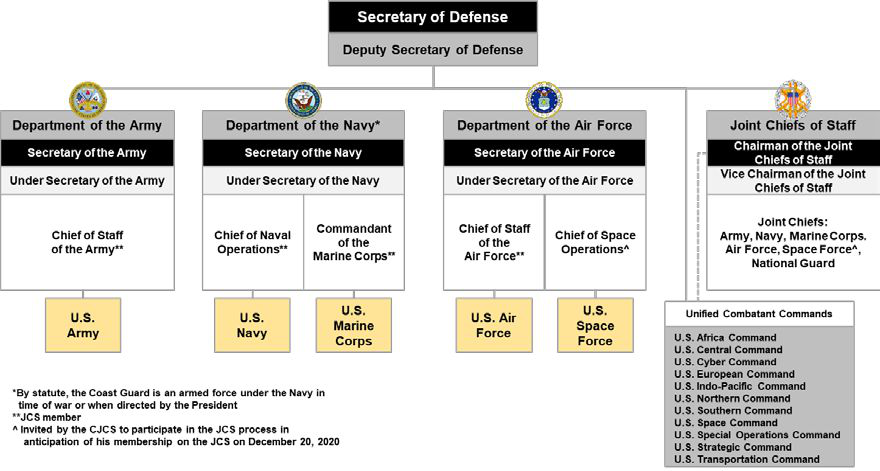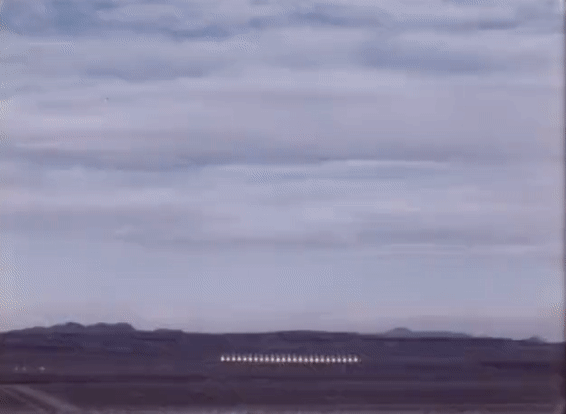|
Multiple Independently Targetable Reentry Vehicle
A multiple independently targetable reentry vehicle (MIRV) is an exoatmospheric ballistic missile payload containing several warheads, each capable of being aimed to hit a different target. The concept is almost invariably associated with intercontinental ballistic missiles carrying thermonuclear warheads, even if not strictly being limited to them. An intermediate case is the multiple reentry vehicle (MRV) missile which carries several warheads which are dispersed but not individually aimed. All nuclear-weapon states except Pakistan and North Korea are currently confirmed to have deployed MIRV missile systems. The first true MIRV design was the Minuteman III, first successfully tested in 1968 and introduced into actual use in 1970. The Minuteman III held three smaller W62 warheads, with yields of about each in place of the single W56 used on the Minuteman II. From 1970 to 1975, the United States would remove approximately 550 earlier versions of the Minuteman ... [...More Info...] [...Related Items...] OR: [Wikipedia] [Google] [Baidu] |
W87 MX Missile Schematic
The W87 is an American thermonuclear weapon, thermonuclear missile warhead formerly deployed on the LGM-118A Peacekeeper ("MX") Intercontinental ballistic missile, ICBM. 50 MX missiles were built, each carrying up to 10 W87 warheads in multiple independently targetable reentry vehicles (MIRV), and were deployed from 1986 to 2005. Starting in 2007, 250 of the W87 warheads from retired Peacekeeper missiles were retrofitted onto much older Minuteman III missiles, with one warhead per missile. An upgraded version is planned for use on the forthcoming LGM-35A Sentinel ICBM. Description Design of the W87 (now called the W87 Mod 0 or W87-0) started in February 1982 at Lawrence Livermore National Laboratory and production of the warhead began in July 1986 and ended in December 1988.. Its design is reportedly somewhat similar to the W88, though that warhead was designed at Los Alamos National Laboratory. The weapons are part of a National Nuclear Security Administration nuclear weap ... [...More Info...] [...Related Items...] OR: [Wikipedia] [Google] [Baidu] |
R-36 (missile)
The R-36 () is a family of intercontinental ballistic missiles (ICBMs) and space launch vehicles (Tsyklon) designed by the Soviet Union during the Cold War. The original R-36 was deployed under the GRAU index 8K67 and was given the NATO reporting name SS-9 Scarp. It was able to carry three warheads and was the first Soviet MIRV (multiple re-entry vehicle, multiple independently targetable re-entry vehicle) missile. The later version, the R-36M, also known as RS20, was produced under the GRAU designations 15A14 and 15A18 and was given the NATO reporting name SS-18 Satan. This missile was viewed by certain United States analysts as giving the Soviet Union Pre-emptive nuclear strike, first strike advantage over the U.S., particularly because of its rapid silo-reload ability, very heavy throw weight and extremely large number of atmospheric re-entry, re-entry vehicles. Some versions of the R-36M were deployed with 10 warheads and up to 40 penetration aids and the missile's high thro ... [...More Info...] [...Related Items...] OR: [Wikipedia] [Google] [Baidu] |
Cluster Munition
A cluster munition is a form of air-dropped or ground-launched explosive weapon that releases or ejects smaller submunitions. Commonly, this is a cluster bomb that ejects explosive bomblets that are designed to kill personnel and destroy vehicles. Other cluster munitions are designed to destroy runways or electric power transmission lines. Because cluster bombs release many small bomblets over a wide area, they pose risks to civilians both during attacks and afterwards. Unexploded bomblets can kill or maim civilians and unintended targets long after a conflict has ended, and are costly to locate and remove. This failure rate ranges from 2 percent to over 40 percent. Cluster munitions are prohibited for those nations that ratified the Convention on Cluster Munitions, adopted in Dublin, Ireland, in May 2008. The Convention entered into force and became binding international law upon ratifying states on 1 August 2010, six months after being ratified by 30 states. As of 10 F ... [...More Info...] [...Related Items...] OR: [Wikipedia] [Google] [Baidu] |
Thermonuclear Weapon
A thermonuclear weapon, fusion weapon or hydrogen bomb (H-bomb) is a second-generation nuclear weapon design. Its greater sophistication affords it vastly greater destructive power than first-generation nuclear bombs, a more compact size, a lower mass, or a combination of these benefits. Characteristics of nuclear fusion reactions make possible the use of non-fissile depleted uranium as the weapon's main fuel, thus allowing more efficient use of scarce fissile material. Its multi-stage design is distinct from the usage of fusion in simpler Boosted fission weapon, boosted fission weapons. The first full-scale thermonuclear test (Ivy Mike) was carried out by the United States in 1952, and the concept has since been employed by at least the five recognized List of states with nuclear weapons#Recognized nuclear-weapon states, nuclear-weapon states and United Nations Security Council, UNSC Permanent members of the United Nations Security Council, permanent members: the Nuclear weapons ... [...More Info...] [...Related Items...] OR: [Wikipedia] [Google] [Baidu] |
United States Department Of Defense
The United States Department of Defense (DoD, USDOD, or DOD) is an United States federal executive departments, executive department of the federal government of the United States, U.S. federal government charged with coordinating and supervising the six U.S. armed services: the United States Army, Army, United States Navy, Navy, United States Marine Corps, Marines, United States Air Force, Air Force, United States Space Force, Space Force, the United States Coast Guard, Coast Guard for some purposes, and related functions and agencies. As of November 2022, the department has over 1.4 million active-duty uniformed personnel in the six armed services. It also supervises over 778,000 National Guard (United States), National Guard and reservist personnel, and over 747,000 civilians, bringing the total to over 2.91 million employees. Headquartered at the Pentagon in Arlington County, Virginia, just outside Washington, D.C., the Department of Defense's stated mission is "to provid ... [...More Info...] [...Related Items...] OR: [Wikipedia] [Google] [Baidu] |
Lawrence Livermore National Laboratory
Lawrence Livermore National Laboratory (LLNL) is a Federally funded research and development centers, federally funded research and development center in Livermore, California, United States. Originally established in 1952, the laboratory now is sponsored by the United States Department of Energy and administered privately by Lawrence Livermore National Security, LLC. The lab was originally established as the University of California Radiation Laboratory, Livermore Branch in 1952 in response to the detonation of the Soviet Union's first atomic bomb during the Cold War. It later became autonomous in 1971 and was designated a national laboratory in 1981. Lawrence Livermore Lab is primarily funded by the United States Department of Energy, U.S. Department of Energy and it is managed Privately held company, privately and operated by Lawrence Livermore National Security, LLC (a Public-private partnerships in the United States, partnership of the University of California, Bechtel, BW ... [...More Info...] [...Related Items...] OR: [Wikipedia] [Google] [Baidu] |
First-strike
In nuclear strategy, a first strike or preemptive strike is a preemptive surprise attack employing overwhelming force. First strike capability is a country's ability to defeat another nuclear power by destroying its arsenal to the point where the attacking country can survive the weakened retaliation while the opposing side is left unable to continue war. The preferred methodology is to attack the opponent's strategic nuclear weapon facilities (missile silos, submarine bases, bomber airfields), command and control sites, and storage depots first. The strategy is called counterforce. Historical background ''First-strike attack'', the use of a nuclear first strike capability, was greatly feared during the Cold War between NATO and the Soviet Bloc. At various points, fear of a first strike attack existed on both sides. Misunderstood changes in posture and well understood changes in technology used by either side often led to speculation regarding the enemy's intentions. 1948 ... [...More Info...] [...Related Items...] OR: [Wikipedia] [Google] [Baidu] |
Dnipro
Dnipro is Ukraine's fourth-largest city, with about one million inhabitants. It is located in the eastern part of Ukraine, southeast of the Ukrainian capital Kyiv on the Dnieper River, Dnipro River, from which it takes its name. Dnipro is the Capital (political), administrative centre of Dnipropetrovsk Oblast. It hosts the administration of Dnipro urban hromada. Dnipro has a population of Archeological evidence suggests the site of the present city was settled by Cossacks, Cossack communities from at least 1524. Yekaterinoslav ("glory of Catherine") was established by decree of the Emperor of all the Russias, Russian Empress Catherine the Great in 1787 as the administrative center of Novorossiya Governorate, Novorossiya. From the end of the 19th century, the town attracted foreign capital and an international, multi-ethnic workforce exploiting Kryvbas iron ore and Donbas coal. Renamed Dnipropetrovsk in 1926 after the Ukrainian Communist Party of the Soviet Union, Communist ... [...More Info...] [...Related Items...] OR: [Wikipedia] [Google] [Baidu] |
Intermediate-range Ballistic Missile
An intermediate-range ballistic missile (IRBM) is a ballistic missile with a range (aeronautics), range between (), categorized between a medium-range ballistic missile (MRBM) and an intercontinental ballistic missile (ICBM). Classifying ballistic missiles by range is done mostly for convenience. In principle there is little difference between a high-performance IRBM and a low-performance ICBM, because decreasing payload mass can increase the range over the ICBM threshold. The range definition used here is used within the U.S. Missile Defense Agency. History The progenitor for the IRBM was the Aggregate (rocket family)#A4b/A9, A4b rocket, winged for increased range and based on the famous V-2 rocket, V-2, Vergeltung, or "Reprisal", officially called Aggregate series, A4, rocket designed by Wernher von Braun. The V-2 was widely used by Nazi Germany at the end of World War II to bomb English and Belgian cities. The A4b was the prototype for the upper stage of the Aggregate (rock ... [...More Info...] [...Related Items...] OR: [Wikipedia] [Google] [Baidu] |
Oreshnik (missile)
Oreshnik (), is a Russian intermediate-range ballistic missile (IRBM) characterized by its reported speed exceeding , according to the Ukrainian military. The missile is equipped with six warheads, each reportedly containing submunitions, and has been described as highly difficult to intercept, though modern ballistic missile interceptors are designed to counter this type of system. Deputy Pentagon Press Secretary Sabrina Singh has identified the Oreshnik as a variant of the RS-26 Rubezh IRBM. History Development Oreshnik is believed to be derived from the RS-26 Rubezh IRBM, which has been test-fired five times but never entered service. According to experts, the Oreshnik likely removed a booster stage from the RS-26, reducing its range. First operational use The Oreshnik saw its first confirmed operational use on 21 November 2024, during the Russo-Ukrainian War. The missile was employed in an attack on Ukraine's PA Pivdenmash facility in Dnipro. Initially, Ukrainia ... [...More Info...] [...Related Items...] OR: [Wikipedia] [Google] [Baidu] |
Arms Race
An arms race occurs when two or more groups compete in military superiority. It consists of a competition between two or more State (polity), states to have superior armed forces, concerning production of weapons, the growth of a military, and the aim of superior military technology. Unlike a racing, sporting race, which constitutes a specific event with winning interpretable as the outcome of a singular project, arms races constitute spiralling systems of on-going and potentially open-ended behavior. The existing scholarly literature is divided as to whether arms races correlate with war. International-relations scholars explain arms races in terms of the security dilemma, engineering spiral models, states with Revisionist state, revisionist aims, and Deterrence theory, deterrence models. Examples Pre-First World War naval arms race From 1897 to 1914, a Anglo-German naval arms race, naval arms race between the United Kingdom and German Empire, Germany took place. Br ... [...More Info...] [...Related Items...] OR: [Wikipedia] [Google] [Baidu] |
Anti-Ballistic Missile Treaty
The Anti-Ballistic Missile Treaty, also known as the ABM Treaty or ABMT, was an arms control treaty between the United States and the Soviet Union on the limitation of the anti-ballistic missile (ABM) systems used in defending areas against ballistic missile-delivered nuclear weapons. It was intended to reduce pressures to build more nuclear weapons to maintain Deterrence theory, deterrence. Under the terms of the treaty, each party was limited to two ABM complexes, each of which was to be limited to 100 anti-ballistic missiles. Signed in 1972, it was in force for the next 30 years. In 1997, five years after the Dissolution of the Soviet Union, dissolution of the Soviet Union, four Post-Soviet states, former Soviet republics agreed with the United States to succeed the USSR's role in the treaty, with Russia assuming all rights and obligations as the Succession of states#Russia and the Soviet Union, successor state of the Soviet Union. Citing purported risks of nuclear blackmail, ... [...More Info...] [...Related Items...] OR: [Wikipedia] [Google] [Baidu] |








